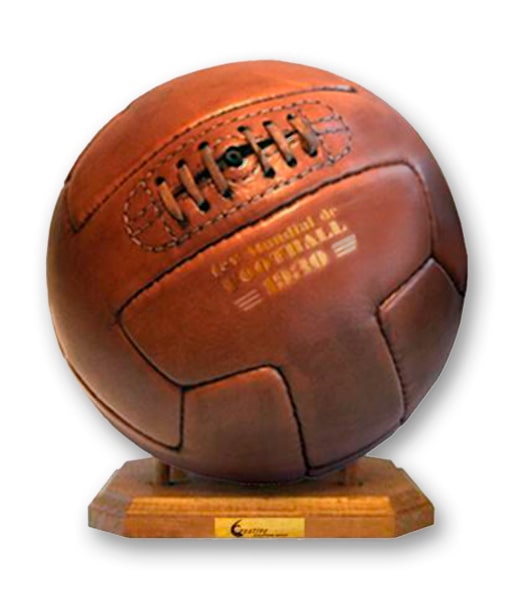
The history of the soccer ball covers all details about its evolution along the ages.
Though maybe your biggest curiosity is really knowing… who invented the soccer ball?
Who was it? How did it happen? Where? And, why?
That’s exactly what I’ll be revealing here!
Want to learn even more about the invention of the soccer ball?
Keep on reading!
I’ll teach you about everything that lead to that moment in time, with an exciting take on the history of the soccer ball.
Here’s what you’ll learn from this post…
Table of Contents

Who Invented the Soccer Ball?
The inventor of the first soccer ball of modern age is considered to be Charles Goodyear and he did it 1855.
Here’s an illustration of Charles Goodyear that was published in 1891 on a «Scientific American» article. Charles does look like a good old sport, doesn’t he? 🙂
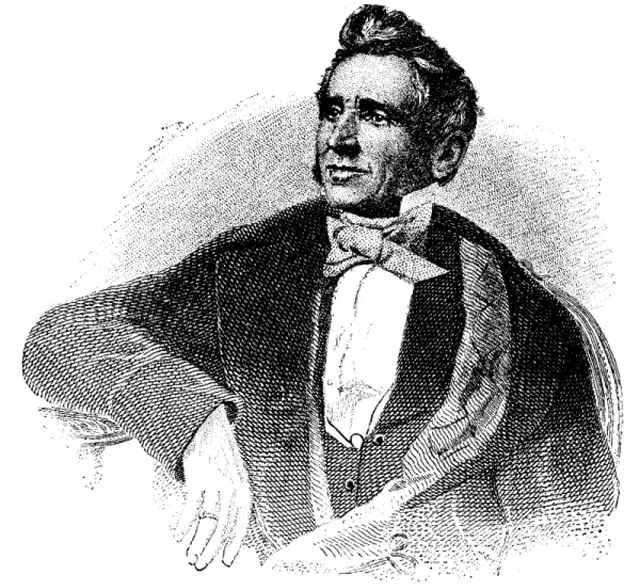
Who Was Charles Goodyear?
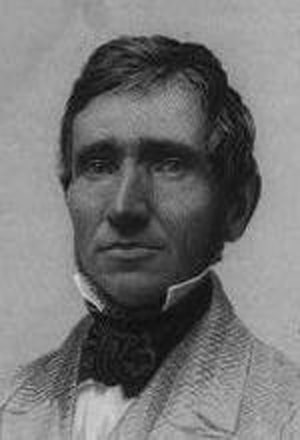
Charles Goodyear was born on December 29th, 1800 in New Haven, New York and died on July 1st, 1860.
He was an American self-taught chemist and manufacturing engineer who invented the vulcanization process of rubber.
Modern evidence has shown and proven that the Mesoamericans already used stabilized rubber in 1600 BC for objects like balls and other things, though.
How Did Goodyear Invent Vulcanized Rubber?
Charles Goodyear found out about natural rubber (gum elastic) between the years 1831 and 1832.
He gathered all the information that he could about it reading every newspaper article that mentioned natural rubber.
At the same time, some of Roxbury Rubber Company’s goods got Goodyear’s attention.
He visited Roxbury’s plant and saw some products he thought he could improve (particularly, inflation tubes for life preservers). He went back home, made some tubes of his own and went back show them to Roxbury’s manager.
However, the company wasn’t doing well.
Thousands of rubber products were being returned and Roxbury was close to fail.
The rubber had rotten making the products of no use.
Goodyear’s life goal: develop stable and durable rubber
It was in this moment in time that made Charles Goodyear dedicate his life effort in developing a more stable and durable rubber.
He tried different ways, combinations, mixtures and processes to make rubber lose its stickiness and become durable.
Along the way he made rubber shoes and other rubber goods, but he couldn’t find a way to develop a stable form of rubber.
EUREKA! Goodyear invents vulcanized rubber
Finally, after many years of experiments with India rubber (natural rubber) and many fails, Charles Goodyear developed vulcanized rubber.
It happened in a small factory Goodyear owned in Springfield, Massachusetts that was run by his brothers Nelson and Henry.
Charles Goodyear continued perfecting the vulcanization process until it was safe enough to take out a patent for it. Which he did on June 15, 1844 (United States Patent Office’s patent #3633).
Years later, in 1855, Charles Goodyear invented the first round soccer ball in History.
Now it’s for you and me to plunge into the amazing facts of the history of the soccer ball so you can learn how Charles Goodyear’s invention fits in it.
History of the Soccer Ball
Or as people would say back home: history of the football ball…
Ever since the beginning of times soccer-like sports have been played all over the World.
The game evolved alongside human civilization and so did the soccer ball and other soccer related gear.
Let’s do a quick travel back in time to learn more about the history of the soccer ball.
Ancient Forms of Soccer
Over 3,000 years ago, ancient civilizations invented the first soccer ball in History and the very first forms of the sport itself.
Chinese ‘Tsu Chu’
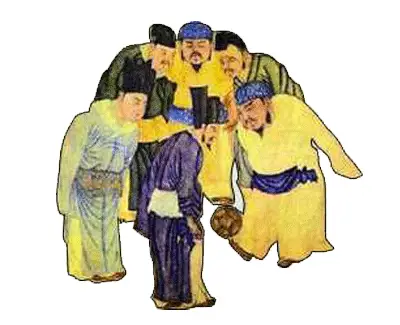
During Ts’in and Han Dynasties (255 BC-220 AD), Chinese used to play a game called ‘Tsu Chu’.
They used balls made of animal skin stuffed in a spherical form.
‘Tsu Chu’ players had to dribble those animal-skin balls through gaps in a net tied between two poles.
Egyptians Rites
The ancient Egyptian people performed rites that had similarities with soccer.
They used balls where seeds were wrapped in linen.
So they could bounce better Egyptians also made balls using catgut or animal skin.
Aztec and Maya Indians
South American civilizations such as the Aztec and the Maya are reported to have used a light elasticized ball.
Their ball was made from natural latex found in rubber wood.
Greeks and Romans
The ancient Greek and Roman civilizations also played an important role adding their own contributions to the first soccer balls in History.
Their ancient versions of soccer consisted kicking and carrying a ball.
Like the Egyptians, Greeks made their balls where hair (instead of seeds) was wrapped in linen.
Pig Bladder Soccer Ball
The sport of soccer (or football, if you prefer) had already become very popular by Medieval times.
People used their feet and hands to bounce the ball in the air.
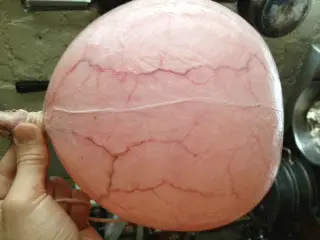
Due to the greater importance of the game, a custom was to use pig bladders and inflate them in order to made better soccer balls.
Pig bladders become the most common material for soccer balls in the Middle Age.
A good example of it is the pig bladder ball Italians used in the 17th Century.
Because of their lack of shape retention (that made them harder to play with) and ease of rupture, pig bladders started to have leather covers.
With leather covers, soccer balls became rounder and lasted longer.
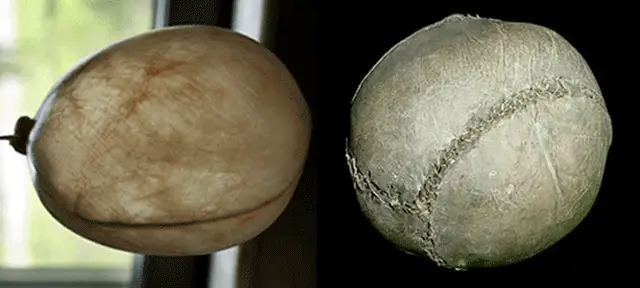
The Birth of the Modern Soccer Ball
By the 1800’s, at the birth of its professional age, football was already seen as a recognized sport.
Making better and more reliable balls become even more important.
Vulcanized Rubber
In 1844, Charles Goodyear invented and patented vulcanized rubber.
This invention would allow more control over the size and shape of balls just a few years later.
First Round Soccer Ball
The evolution of the soccer ball reached a fundamental mark in the year of 1855.
Charles Goodyear was the man who invented the first soccer ball, when he designed and made the first round vulcanized rubber soccer ball.
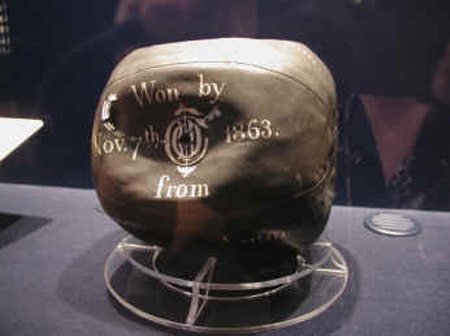
Prior to this, balls pretty much depended on the shape and size of the bladder that was extracted from the pig so they weren’t entirely round.
Natural rubber wasn’t used to make soccer balls either because it became deformed in hot conditions and it was very sticky to play with also.
This American self-taught chemist and manufacturing engineer, considered as the inventor of the modern soccer ball, solved both problems with his new method of treating rubber.
Vulcanization allowed rubber to become more durable and solid while still maintaining its bouncing characteristics.
First Inflatable Soccer Ball Rubber Bladders
Richard Lindon, an English leatherworker from Rugby, England, was led to develop a replacement for pig bladders due to the ill effects that blowing up pig bladders had.
His wife had previously died from lung disease that might have been caused for blowing up too many infected pig bladders.

In 1862, Richard Lindon found an alternative to pig bladders when he developed a bladder using India rubber (natural rubber, also called caoutchouc).
This new rubber bladder was too hard to inflate by mouth and Lindon, inspired by a medical ear syringe, made a larger brass version to pump up his footballs.
Lindon had just made one of the very first inflatable bladders for balls in History.
These type of bladders were harder and maintained their shape better.
Nevertheless, it was not before the 20th century that rubber bladders were part of the majority of soccer balls used.
First Official Soccer Ball Size and Shape
As referred above, the dimensions of the soccer ball depended on the shape and size of the pig bladder. There were no rules set on the dimensions of the ball.
Thanks to Charles Goodyear’s vulcanized rubber invention it was now possible to produce soccer balls with the same shape and size. This meant the official dimensions of the soccer ball could already be set.
The English Football Association (FA) had just been formed when it met to set the first rules of the game in 1863.
Nothing was referred about the ball description in the first version of the rules, though.
In 1872, FA revised the rules of the game and officially declared that the ball should be spherical with a circumference between 27 and 28 inches (68.6 cm and 71.1 cm) and a weight of 16 oz to 14 oz at the start of the match.
This is still the official soccer ball size according to FIFA’s law 2 of the game.
The specification of the soccer ball dimensions coincided with Charles Goodyear’s invention of the vulcanized rubber soccer ball.
Therefore, Goodyear is considered as the inventor of the soccer ball of modern times.
Modern Period of Soccer & Its Soccer Ball
In 1888, with the establishment of the English Football League, mass-production of leather balls first started.
Despite the invention of the rubber soccer ball by Charles Goodyear in 1855, leather balls remained widely used in the late 1800’s.
Two of the first companies to mass produce soccer ball at the beginning of the English Football League were Mitre and Thomlinson’s of Glasgow.
Those companies pointed out that the most important element in a quality soccer ball would be how well it could retain its shape.
The most skilled cutters and stitchers were hired and the strongest leather was used.
The rump of cow provided the best leather for the highest quality balls while leather from cow shoulder was used for the lower quality ones.
The introduction of interlocking panels (instead of formerly used leather sections joined at the north and south poles of the soccer ball) allowed advances in ball design that led to the production of balls with a more rounder shape.
Soccer balls of this time were made of various panels of leather with a lace at one point to protect the inner bladder.
Soccer Balls of the 1900’s
When the 1900’s came, soccer balls were made with stronger rubber which allowed them to endure heavier pressure.
By that time, most of the produced balls used rubber bladders. Inner tubes covered with heavy brown leather made the balls bounce better and still be kicked well.
The majority of soccer balls had a cover made of tanned leather with eighteen sections (six panels of three strips).
Stitching was done by hand with five-ply hemp and with the ball’s cover inside out. When completed, the cover was turned over so that the stitching was kept on the inside.
A 15 cm slit on the outer side of the cover was used to insert an uninflated bladder.
Bladders had a long stem neck extending from them in order to be inflated. When the ball was inflated, the tube was inserted back inside the cover and the slit was laced up firmly.
This type of soccer balls couldn’t hold their air for too long.
They had to be reinflated even during matches.
First World Cup Soccer Ball
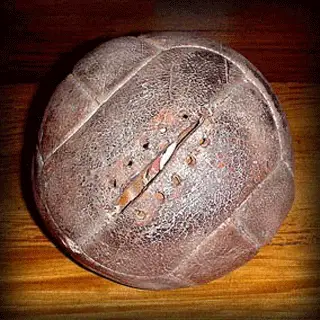
The laced ball was the type of soccer ball used in the inaugural 1930 FIFA World held in (and won by) Uruguay from July 13 to July 30, 1930.
Before FIFA standardized soccer ball’s type, size and weight, countries couldn’t agree on which type of ball to use during international matches. Some favored one type of soccer ball, others preferred a different one.
This kind of controversy actually happened during the final of the first World Cup in History held in Uruguay.
Argentina and Uruguay made it to the final but could not reach an agreement on which ball to use.
Both teams solved this issue by playing the first half of the match with an Argentinian ball and the second half with a Uruguayan provided soccer ball.
By halftime Argentina was winning by 2 – 1 but, in the second half, Uruguay turned things around and won the match by 2 – 4.
This only goes to show that the used soccer balls may actually contributed to the outcome of the 1930 World Cup.
World War II Soccer Ball Enhancements
When the World was facing its second global war, soccer balls continued to evolve.
A carcass made of strong cloths was added between the bladder and the outer cover which allowed more control over the shape of ball, made it stronger and provided damping.
Despite of the ball improvements, many times they would just simply burst during a match, making them important factors in the outcome of games.
Poor quality of leather covers was the appointed reason for the low quality soccer balls after World War II.
Cow hides used to vary in quality and in thickness which made them degrade during matches.
Water-Proof & Colored Soccer Balls
Leather balls became very heavy and painful when heading under rain conditions due to the high water absorption characteristics of the leather and to the hard stitching of the lace.
Countless head injuries were caused by heavy wet leather soccer balls.
By the 1950’s, synthetic paints and other non-porous materials were used to coat the leather which lowered soccer ball’s water absorption.
Finally, the soccer ball’s laced slit was removed due to the invention of new kind of valve, allowing the ball surface to become more regular, smoother and the soccer ball easier to control.
When floodlights were introduced, to facilitate ball visibility for everyone (both players and spectators) white colored soccer balls were first allowed.
Nevertheless, white balls had been unofficially used since 1892.
Back then cover leathers were simply white washed to make white soccer balls.
Orange soccer balls also started to be manufactured by the first time in the 1950’s also to be improve visibility during snowy matches.
Synthetic Soccer Balls
The first soccer ball made entirely of synthetic materials was only produced in the 1960’s.
General feeling was that leather balls had a more consistent flight and a better bounce, so soccer had to wait until the late 1980’s for this new technology to totally replace leather covered balls.
Today’s soccer balls are made of synthetic materials that emulate the quality of leather and its cell structure but with lower water absorption.
Buckminster Type Soccer Ball

American architect Richard Buckminster Fuller came up with a new soccer ball design when he was looking for a new way of constructing buildings with a minimum of materials.
His design was properly named ‘Buckminster Ball’ or ‘Buckyball’ and consisted in a series sewed hexagons, pentagons and triangles patches to create a round shape.
Before thermal bonding was introduced (in 2004 with the Roteiro soccer ball), the Buckminster ball with its 20 hexagonal and 12 pentagonal surfaces was considered the modern soccer ball with its near perfect sphere shape.
White Buckminster balls with black spots (that helped players notice any swerves on the ball) became very popular in the sport.
Today’s Soccer Ball
FIFA’s world cup competitions are responsible for many of the innovations that the soccer ball has had.
Let’s take a look at how some of the more recent ones helped a great deal in the ball’s evolution.
1970’s Black & White Soccer Ball
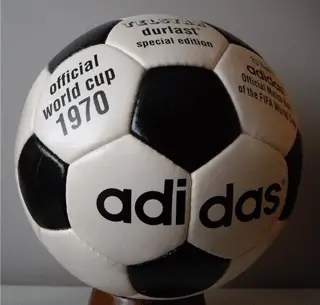
One of the most well-known soccer icons — the black & white soccer ball -– was specially made by Adidas for the 1970 World Cup (held in Mexico and won by Brazil).
It was named after the Telstar space satellite because the resemblances between the two.
It was composed of 32 panels, where 20 were white and 12 black.
Its color combination helped the ball become more perceptible on black-and-white TVs.
For the 1974 World Cup (held and on by West Germany) two updated versions of the Adidas Telstar were used: a black and white one named Telstar Durlast and an all-white one named Adidas Chile.
FIFA announced an official soccer ball for the first time in its history during that tournament.
2006 Adidas Teamgeist Soccer Ball
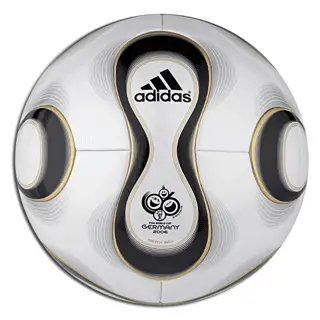
For the 2006 FIFA World Cup (held in Germany and won by Italy), Adidas introduced more innovations to the soccer ball.
Instead of a 32-panel ball — which has common until that tournament –- the new Teamgeist soccer ball had just 14 panels.
Teamgeist (means “team spirit” in German) had panels bonded together instead of stitched ones. The lower number of panels and absence of inner stitches made the ball even smoother and rounder for greater control and increased playability.
2010 Adidas Jabulani Soccer Ball
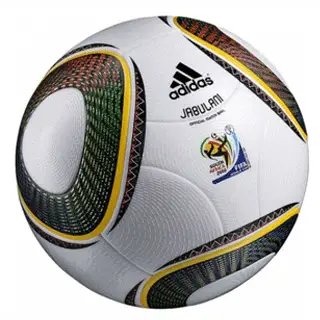
Fast forward four years…
Adidas came up with a new 8-panel soccer ball for the 2010 World Cup (held in South Africa and won by Spain).
Improved polyurethane materials were used to make this soccer ball which –- along with its only 8 panels –- boosted the ball’s feel and behavior.
It was named Jabulani — it means “celebrate” in Zulu, one of South Africa’s official languages.
2014 Adidas Brazuca Soccer Ball
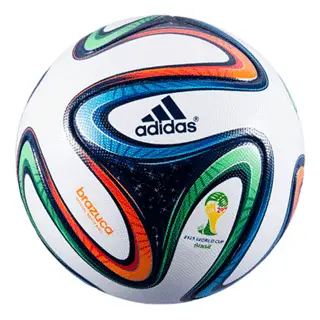
In the 2014 FIFA World Cup (held in Brazil and won by Germany), Adidas launched another new football which was named Brazuca (Portuguese slang word for “Brazilian”).
The Brazuca soccer ball had even fewer panels than its predecessor (the Jabulani): only six polyurethane thermally bonded panels!
This reduction in the number of panels increased the ball’s consistency and avoided the aerodynamic problems the Jabulani ball had.
Conclusion
There you have it!
Now you know a little bit more about the history of the soccer ball and that Charles Goodyear was the one who invented it back in 1855.
You also learnt that similar sports to soccer have been played for centuries and centuries, maybe even before the Chinese and their ‘Tsu Chu’ game.
Football and footballs — or soccer and soccer balls — have come a long way since the very first man kicked a stone for the first time.
Soccer ball evolution is not going to stop, though, brands, players, coaches and fans all over the World demand better and improved technologies for the sport and its gear.
The quest for the best soccer ball will live on forever!


